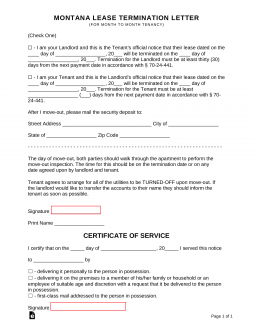Updated February 23, 2024
A Montana eviction notice is a formal letter used to notify a tenant of a lease violation. The most common infraction is for non-payment, but the notice can be used for any type of lease non-compliance.
By Type (1)
 Notice to Quit for All Eviction Types – Check the appropriate box for the following time period that best matches the tenant’s infraction. Notice to Quit for All Eviction Types – Check the appropriate box for the following time period that best matches the tenant’s infraction.
Download: PDF |
Table of Contents |
Prohibited Landlord Actions
Utility Shutoff – If a landlord purposefully interrupts a tenant’s essential utility services — such as heat, running water, hot water, electricity, or gas — the tenant may terminate the rental agreement and recover up to three months’ rent.[6]
Changing the Locks – If a landlord unlawfully removes a tenant from their unit without a court order, the tenant may terminate the rental agreement and recover up to three months’ rent.[6]
Court Forms
Guide – Instructions and forms provided by the state on how to evict a tenant.
Complaint for Possession – The landlord must file this document to begin an eviction case, in it they will describe their reason for eviction.
Summons – The summons form is served on the tenant to inform them of the case against them.
Request Serve Documents – This document formalizes a request to have the summons served on the tenant.
Request a Hearing – This form will be completed by the court when a hearing date is set.
Judgment – This document will record the court’s verdict.
Answer – The tenant may rebut the landlord’s complaint by filing an answer with the court.
Writ of Assistance – If the tenant fails to vacate after a judgment in the landlord’s favor, this document is used as a last resort to have them removed by the sheriff.
How to Evict a Tenant (4 steps)
- Provide Eviction Notice to Tenant
- File Complaint and Summons with Local Court / Serve Tenant
- Attend Hearing / Receive Court Judgment
- Obtain Writ of Assistance (If Necessary)
1. Provide Eviction Notice to Tenant
The first thing a landlord must do is provide the requisite notice to the tenant of the violation and the intent to seek redress in court if the tenant fails to make the changes required, the payments required, or fails to move out as directed. A landlord can use this form to notify tenants making sure that he or she provides the correct time period for the tenant to respond upon receiving notice.
2. File Complaint and Summons with Local Court / Serve Tenant
If the tenant fails to respond, the landlord may file a Complaint and Summons in the City Court, Municipal Court, Justice Court, or District Court. In addition, the landlord will have to file a Request to Serve in order to have the sheriff properly serve the tenant with the Complaint and Summons.
Filing fees vary by county. For example:
3. Attend Hearing / Receive Court Judgment
The tenant will have 10 days to Answer after receiving the complaint (View Guide to Answer an Eviction). If the tenant doesn’t answer, the landlord may receive a Judgment from the court. If the tenant does answer, the court will set a hearing within 20 days after the landlord files a Request.
4. Obtain Writ of Assistance (If Necessary)
If the landlord prevails, but the tenant still fails to move out, he or she may apply for a Writ of Assistance to get the sheriff to move the tenant out.
Sources
- Mont. Code § 70-24-422(2)
- Mont. Code § 70-24-422(1)(d)
- Mont. Code § 70-24-422(3,4)
- Mont. Code § 70-24-441(2)
- Mont. Code § 70-24-427
- Mont. Code § 70-24-411
- County of Yellowstone Justice Court – Civil Cases
- Gallatin County Clerk of the District Court – Fee Schedule
- Missoula County Justice Court – Civil Division


